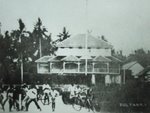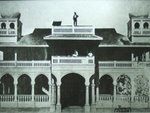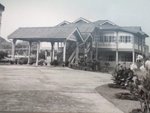[Note: The following article was published in the Golden Legacy Column in Brunei's national newspaper, The Brunei Times, on 2nd June 2007]History sometimes overlooked the small people. Yet these are the people who mattered.
In the Brunei history too, one of the overlooked group of people are the 'pengalu'. Among Bruneians, some of the words used extensively in its old history have been forgotten. Most might remember the more colourful 'padians' - the group of women vendors who used to ply goods from house to house on the Kampong Ayer.
But with the word 'pengalu', most might not even know what the word stands for. Some mistakenly called them the male version of padians which could not be more wrong. It is a pity that many Bruneians have forgotten that 'pengalu' played a very important role in the Brunei commerce as well as in the development of Brunei history.

In the old days, Brunei among others exported camphor, tortoise shells, sandalwood and wild bees' honey. It is obvious that a number of these exports have to be obtained from the interior part of the Brunei Thalasocracy on the Borneo Island. Camphor can be gotten from the area around the Sabah hills and was said to be among the best in the region.
Those who lived in the interior would have to trade them with those who are able to export them by getting some of the things that they needed. A group of middlemen appeared bridging the gap between the exporters and the producers. These middlemen are known as the ‘pengalu’ – but pengalus are more than just middlemen.
They would venture into the interior through the Brunei rivers in their boats and bring whatever goods the natives living in the interior needed and exchanged them for the exportable goods. They would then bring those goods and produce outside and would trade them with the captains of seafaring vessels or with the padians.
Pengalu became the most important people in the whole trading chain. By having them as middlemen, they became the focal communication and transportation link between the various groups and between the coastal business and the interior business. By being the middlemen too, they also unofficially became the communication point between the government in the coastal areas and those in the interior.
Unofficially they also functioned as the agents in bringing communication between families, given the trust to deliver news and to bring information in many aspects from the government to those in the outlying districts.
The padians on the other hand concentrated in their water village areas but as we have seen, pengalus go further than that. Pengalus were not just limited from those in the Kampong Ayer area which was the seat of the central Brunei government then. But pengalus also operated from other Brunei government representatives in the coastal areas at the mouth of the major Borneo rivers then which included those in Limbang, Lawas, Terusan and Awat-Awat as well as other areas in the Borneo Island.
Those in the interior would normally use an area by the river waiting for the coming of these pengalus. These waiting areas eventually became villages in their own right. Kampong Kilanas was one such area.
One of the produce of the area then was pineapple or in Malay ‘nenas’. Pengalus would paddle up the Brunei River, down the Damuan River and enter the small Kilanas River and there the villagers would be waiting for the pengalus with their produce including their pineapples. Eventually that area became known as the present Kilanas Village.
A number of such villages have their origins from these river trades and pengalus played a major part in obtaining produce from these villages. Among the major inland centres that have been identified to be used by these activities included Limau Manis, Lugu, Menglait, Kiarong and Tungku.
Pengalus played an important part in the Brunei economy up to the 1970s before they disappeared from the commercial world. They usually practice barter trading rather than pay for the goods with money. In the 1950s, it was said that one gantang of rice can be traded for three katis of salted dried fish or two katis of smoked fish.
Traveling by the rivers and depending on the distance that these pengalus have to go to, a journey took more than a few days. After a few days, these pengalus would return back to their bases and most often they would stop at the place where both the pengalus and padians would meet to trade their goods with each other.
These places included the Labuhan Kapal (where the Bandar Seri Begawan wharf is currently), Kampung Kuala Peminyak, Kampung Saba and Kampung Lorong Sikuna. Kampong Lorong Sikuna is said to be named after the English word Schooner as British ships would use that place for berthing. The padians would then take the goods and would peddle them among the residents of Kampong Ayer.

One of the interesting developments of the tools of the pengalus was the boats that they used. Some pengalus travel far and wide and so they would be using small sailing boats but those that did not, would use a small paddling boat instead. With modernization in the 1950s, the pengalus began using small engine boats to enable them to travel further and faster.
But by then it was the beginning of the end for the pengalus.
Roads were being built into the interior parts of Brunei thus enabling those living inside to be able to come out and sell the goods for themselves for the first time without relying on the pengalus. Shops run by Chinese businessmen began to be built in the new towns and being on dry land, becoming better stocked than what any pengalu boats can bring. Tamu or places where goods and produce are allowed to be sold began to appear in town centres.
Both Pengalus and Padians were slowly becoming anachronistic and by the 1970s and the 1980s, both had disappeared after a few hundred years of being the prominent players in the Brunei commerce.
But what is important was the legacy these Bruneians left us. They were traders.
They were willing to do hard work. And they clearly obeyed the Al-Mighty as in Verse 29 of Surah An-Nisaa “… O ye who believe! Eat not up your property among yourselves in vanities: But let there be amongst you traffic and trade by mutual good-will ...”














